KEEPING OUR MONEY HEALTHY The job of the Federal Reserve System
WE LIVE IN A ‘MONEY ECONOMY’
Whether we're EARNING it for the things we need and want …
SAVING it for future wants …
BORROWING it for immediate use …
SPENDING it on the things we enjoy …
… money is a vital part of our everyday lives.
Money, as we know it, takes two forms: cash money which we carry around with us and checkbook money which many people use to pay their bills. The important thing to remember, though, is that they are interchangeable. We can deposit cash for a checking account. And we can write a check as a substitute for cash.
Money by itself is really useless. But as a medium of exchange it has value. And that value is what money can buy.
|
Ten years ago one dollar could buy:
Today one dollar can buy:
Ten years from now one dollar might buy more, or less, or the same things. |
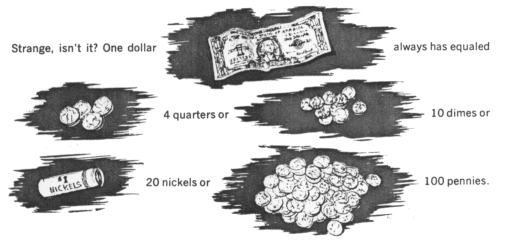
|
The dollar itself doesn’t change. But what the dollar will buy, how much it will buy, does vary.
Why does the value of the dollar change? How does this change affect us? How can we limit the dollar's changing value?
Imagine our economy as one huge machine. Instead of mills, factories, farms, offices and shops, this one machine turns out all our goods and services. Everyone with a job works this Total Production Machine. Some workers repair and maintain it. But most work to produce cars, washing machines, TV sets and houses … almost all the things we need and want.
Of course, everyone who works the machine gets paid. Some are paid in cash. Others are paid by check. In fact, sometimes the check is sent to the worker's bank and deposited to his account.
Then, either with their cash money or checkbook money, people buy things to eat and wear and enjoy. Thus, people work on the machine … get paid by the machine … and buy what the Total Production Machine has produced. When people buy all that the machine has produced, then everything is in balance … the value of our money is stable and healthy. But …
… once in a while, people decide to buy fewer cars. Or the federal government may cut back on the space program. Perhaps local governments will defer building a new school. Or industry decides that there is enough steel in the nation's warehouses. When the demand for its output falls off, then the machine is slowed down.
Fewer people are needed to work it. As incomes are cut off, total buying is even less than before. The machine works still slower and more people are laid off. This state of economic affairs — this imbalance — is called recession.
Sometimes the opposite happens. Instead of cutting back, people, industry and governments may decide to buy more. Up goes demand and our Total Production Machine gets busier. As the demand for its output becomes greater and greater, the machine works harder and longer to produce more cars, more space capsules, more schools, more steel … more of the things that are wanted.
More people are hired to work the machine. Earnings rise. And spending increases … pushing the machine to even greater efforts.
However, there's a limit to what the machine can produce — at stable prices. Working at full throttle the machine must use obsolete and inefficient parts. This is more costly. Further, untrained people must be used and they are less productive. As costs go up, prices go up.
How can we produce more without rising prices? How can growing demand be satisfied at stable prices?
To solve this problem …
… we must improve and enlarge the machine. To produce more at prices that stay level we must add to the machine's capacity. Part of the demand must be postponed … because some of the machine's output must be used to enlarge itself. Instead of immediately making more cars, more washing machines and more TV sets, we need more electric generating plants, more steel mills, more component parts to expand the Total Production Machine.
It seems, though, that people prefer not to postpone their demand but would rather spend their income right away.
Some suggest that we get funds for new parts for the Total Production Machine, as well as cars and other things we want, by creating more money.
The banking system can create more money when people wish to borrow for spending, as we shall see later. This may expand the Total Production Machine's output. But when the machine is working near capacity, the rapid creation of more money through the banking system will not increase production fast enough.
Since we cannot buy more than is being produced, the additional money only increases the competition for the available supply of products. Too many dollars are chasing too few goods. Prices of all kinds of goods will go up. A dollar will not buy as much as before … and its value will go down. This state of economic affairs — this imbalance — is called inflation.
Inflation hurts many people. Those receiving fixed incomes, such as pensioners, find that their dollars buy less. And people with savings accounts find that inflation reduces the value of their savings.
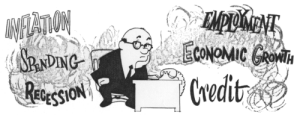 |
Since too little spending leads to recession and too much spending leads to inflation … how much new money is needed to keep our economy growing, employment high, and prices relatively stable? How much would keep output and spending rising in balance together? How much would spill over into inflation? These questions of monetary policy are the basic concern of the Federal Reserve System. |
How does the Federal Reserve System work?
The Federal Reserve System is one of the institutions that influence our nation's economic condition. It seeks to keep our money healthy — by stabilizing its value - within a growing economy. By influencing the money supply, the Fed's monetary policies aim to avoid the extremes of inflation and recession … to encourage high employment and to safeguard the purchasing power of our dollars.
In a way, the Federal Reserve System might be called our money doctor.
A medical doctor tries to prevent as well as cure illness. He examines his patient, studies his physical condition, his medical history, his symptoms. If the patient suffers from a vitamin deficiency, the doctor tries to help the patient to achieve a healthy balance.
Our money doctor,
the Federal Reserve System, also tries to prevent as well as correct economic illness. He is continuously examining his patient's
condition and symptoms … and making economic diagnoses of our country’s financial health. When an imbalance develops, the money doctor
tries to help the economy grow and achieve a healthy balance.
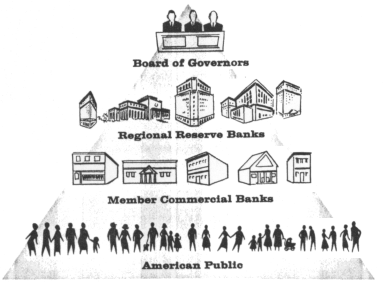 |
Established by Congress in 1913, the Federal Reserve System is composed of 12 regional district banks, supervised by a 7-man Board of Governors in Washington, D.C. These banks serve the public interest by working through about 5,600 member commercial banks. The commercial banks deal directly with us, the American public. Many private citizens participate as directors on the Boards of these district Reserve Banks. They include businessmen, farmers, educators — people who are active in our nation's economy and have wisdom and experience to contribute. |
The Fed influences bank credit. Banks lend us the money to buy cars and washing machines, and they finance the computers of industry and the missiles of government. These credits are added to the borrowers' checking accounts.
As bank lending goes up, the amount of checkbook money on deposit increases. Thus, by influencing how much banks can lend, the Fed's policies affect the size of the money supply. Here's how it works.
Staff advisers continuously study the needs, desires, and buying plans of both consumers and industry. They learn, for example, how many of us are working … how much money we're making … and what we spend it for it. Are we buying cars or houses? Are we buying more than last year? Are we going to let the old appliances do for another year? In diagnosing a patient's condition and arriving at a course of treatment, a doctor is guided by many technical documents. The money doctor
also has tools
to work with. He studies many economic indicators and uses them to evaluate our national economic state of health. This diagnosis helps the money doctor
form decisions to encourage or discourage the ability and willingness of the commercial banks in the country to extend credit … to increase the amount of credit or to decrease it …to lower it the cost of credit or to raise it.
How can influencing the amount and cost of credit
help to stabilize the value of money?
Suppose our money doctor's
research indicates a great boom … that consumers and business are going on a big buying spree.
Businessmen will compete for equipment and labor. Consumers will bid against each other to buy the limited number of cars, washing machines, TV sets and houses that are produced.
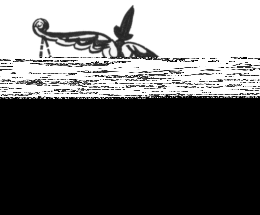 |
What's the danger of this? Prices may shoot up. Remember the story of our Total Production Machine? Its current capacity is limited. So, as we bid for the available supply of goods and services our demand will start to exceed the machine's production capacity and force prices up. And when prices go up, the value or buying power of money goes down.
When the System's policy makers foresee demand developing beyond industry’s capacity to produce at stable prices, they know that this is a danger signal … for then there could be |
But, if our demand could be curbed, prices would not skyrocket. If fewer people were bidding against each other — if our demand were kept in balance with the supply of merchandise — then prices would not go up, and our money would keep its value.
How can the Fed help to curb demand? Well, when people want to spend money before they've earned it, they borrow … they use credit.
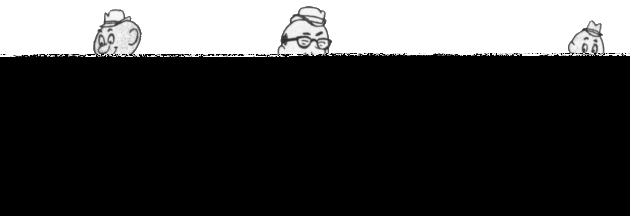
And, you recall, the Federal Reserve System works only with credit. So, to keep prices stable, our money doctor
will prescribe restricting credit. Money gets tight.
And, if credit is harder to get, then fewer people will be able or willing to get it. Thus, there will be fewer people able to bid up the prices of goods.
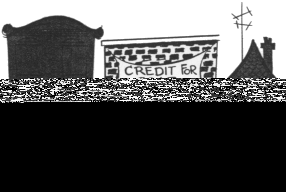 |
Credit, you see, is a |
Credit will still be available. But there will be less credit than is wanted. And as lenders ration the supply, the cost of this credit will be high. Because credit is scarce and expensive, some would-be borrowers will decide not to borrow, and will not buy goods. Prices may not skyrocket and our money may not lose its value.
But suppose our money doctor
expects the opposite — a recession looming ahead. There are plenty of things available for consumers, but it looks as though people will not want to buy or have the money to buy. And as the recession sets in, demand will fall still more as people lose jobs.
How can the Federal Reserve use its powers to battle a recession?
Well, our money doctor
will want to use credit to inject a stimulant into our economy. To increase the buying demand of borrowers, to make it easier and cheaper for us to get credit, the Reserve Banks will exercise their powers to encourage member banks to make more credit available … and at lower interest rates. Money becomes easy.
If it is easier and cheaper to get credit, then consumers, industry, and government can revive their postponed plans.

Then, if demand grows, more and more jobs will be filled to work our Total Production Machine to produce the wanted merchandise.
How the Federal Reserve System affects money and credit
By law, member banks must hold reserves (consisting of their own vault cash and deposits with the Fed) equal to a percentage of their customers' deposits. When a bank finds itself with reserves above the legal minimum (excess reserves) it can create additional credit by making loans. As we learned, such loans are added to borrowers' checking accounts — thus increasing the supply of checkbook money.
Three tools are used by the Fed to affect member bank reserves and thereby influence the bank's ability to make loans. These tools are:
RESERVE REQUIREMENTS
The Fed sets the percentage of reserves that member banks must maintain. If the reserve requirement is 10%, the banks must have $100 in reserves for every $1000 of their customers' deposits. The banks may then create $10 of credit for every excess reserve dollar. Assume that the banking system is one giant bank.
IF RESERVE REQUIREMENT IS 10%
Banking System Deposits …… $1,000
Reserve Required …….………..… 100
Total Reserves ….…………..……. 250
Excess Reserves …..………..…… 150
When reserve requirement is 10%,
each excess reserve dollar can support $10 of credit.
Banks' Lending Ability ………… 1,500
BUT IF THE FED WANTS TO RESTRICT CREDIT,
RESERVE REQUIREMENTS MAY BE INCREASED.
IF RESERVE REQUIREMENT IS 20%
Banking System Deposits ……$1,000
Reserve Required ……….……… 200
Total Reserves ……………………. 250
Excess Reserves …………… … 50
When reserve requirement is 20%,
each excess reserve dollar can support $5 of credit.
Banks' Lending Ability …………… 250
OPEN MARKET OPERATIONS
The Fed, along with other organizations and individuals, buys and sells government securities in the open market.
The Fed does this to affect the supply of credit, not for investment.
When buying, the Fed increases the reserves of the seller's bank. The banking system now may extend more credit. When selling, the Fed decreases the reserve account of the buyer's bank. And, as we know, a smaller reserve account means less credit.
IF RESERVE REQUIREMENT IS 10%
Banking System Deposits ….. $1,000
Reserve Required …….….….…… 100
Total Reserves ………………..…. 250
Excess Reserves …..…………….. 150
Banks' Lending Ability ……… 1,500
WHEN THE SELLER DEPOSITS THE FED'S $100 CHECK,
THE BANK SENDS IT TO THE FED TO BE ADDED TO ITS RESERVE ACCOUNT.
New Deposit ….………………… $ 100
Deposits Now …………….…… 1,100
Reserve Required ……………… 110
Total Reserves ………………… 350
Excess Reserves ……………… 240
Bank's Lending Ability ………… 2,400
DISCOUNT RATES
To avoid having their reserves dip below the required minimum, banks sometimes borrow from the Fed. The interest rate the Fed charges is called the discount rate.
By changing the discount rate, the Fed signals its view on current credit policy to all money lenders. A change in the discount rate affects the cost of borrowing by member banks from the Fed and influences the cost of credit to all borrowers.
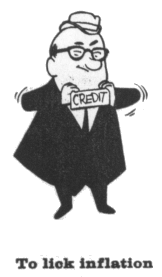 |
Thus, if we seem to be heading into inflation, to decrease demand, the Fed would restrict credit by: a) Raising reserve requirements b) Selling government securities c) Raising discount rates But, if our economy is sliding into a recession, to increase demand, the Fed would expand credit by: a) Lowering reserve requirements b) Buying government securities c) Lowering discount rates |
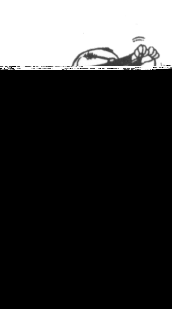 |
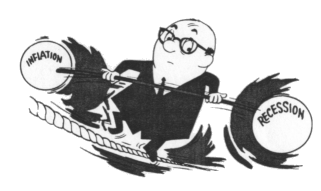 |
Knowing when and how much to restrict or expand credit is not a push-button job. How much lead timeis needed before changing policies? How long a time lag before a new policy’s impact is felt in our economy? That's why avoiding inflation and recession requires a constant watch and great sensitivity to shifting and changing demand in relation to the Total Production Machine. |
But there is another interested doctor
who also contributes to our economic health. During inflationary periods it is not enough for our money doctor
to prescribe a low credit diet. The government's budget doctor
will need to prescribe holding Federal spending within its income.
We can keep our money healthy only if we write prescriptions that are correct and consistent … and if the patient
is willing to cooperate. Otherwise the fever of inflation may continue … prices will rise and the value of our money will decline.
For you see, the taxing and spending policies of federal and local governments, the price and wage decisions of industry and labor, even our own buying habits … all influence our economy as well as Federal Reserve System actions.
Thus, when the problem is inflation, if those of us with savings and cash want to buy more, now … if governments spend more than they take in, now … if labor insists on much shorter hours and much higher wages, now … if industry raises prices instead of increasing efficiency, now … then the value of our dollars will tumble as prices soar.
If recession is what we face, the Fed can help only with a greater supply of inexpensive credit. Borrowing and buying are still up to us. Only increased spending will increase jobs.
The Federal Reserve System will continue to seek an in-between
way that avoids the disastrous extremes of inflation and recession … so that there are jobs for all who want them, money to be earned, plenty of things to buy at reasonably stable prices while America continues to grow.
Copyright 1960 by Federal Reserve Bank of New York — Produced by Schorr and Howard Company
Library of Congress Catalogue No, 60-14368 / Revised, January 1979
Additional information about the Federal Reserve System is available from:
PUBLIC INFORMATION DEPARTMENT
Federal Reserve Bank of New York
22 Liberty Street
New York, N.Y. 10045